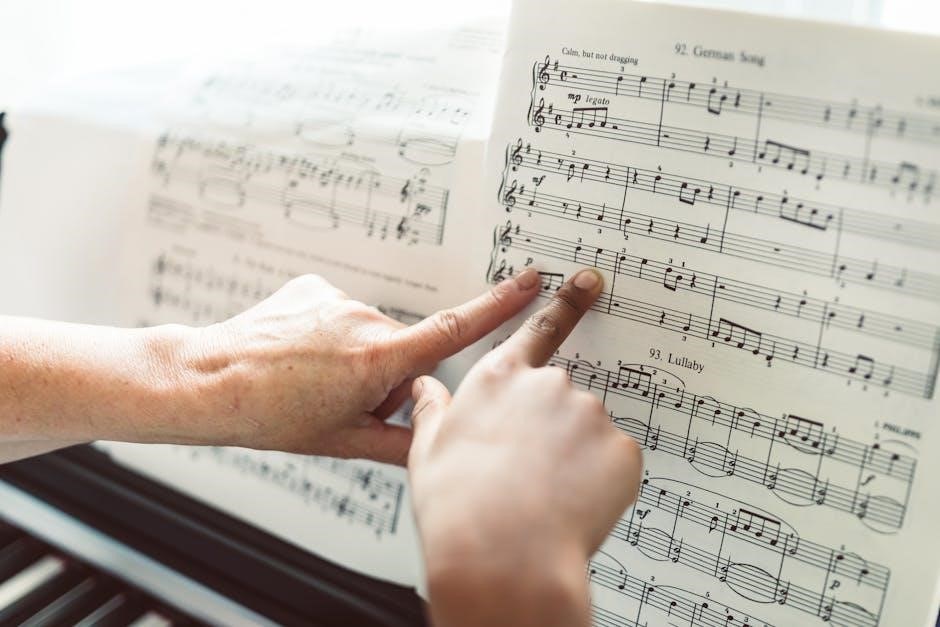“Let It Be” by The Beatles is a timeless song known for its comforting message and emotional depth. Written in C Major, it offers a gentle introduction to piano playing, making it ideal for beginners. Its enduring popularity stems from its universal themes of hope and solace, resonating across generations. The song’s chord progressions and melody provide a perfect balance of simplicity and musicality, making it a great choice for learning and performing. Its cultural impact and soothing melody continue to inspire musicians and music lovers alike, ensuring its place as a classic in piano repertoire.
1.1. Overview of the Song and Its Popularity
“Let It Be” is a timeless ballad by The Beatles, written in the key of C Major. Its soothing melody and heartfelt lyrics have made it a global favorite, resonating with listeners for decades. The song’s universal message of hope and comfort continues to inspire, ensuring its enduring popularity. As a piano piece, it remains widely performed, offering a beautiful blend of simplicity and emotional depth. Its accessibility on piano has further cemented its place as a beloved classic in music repertoire.
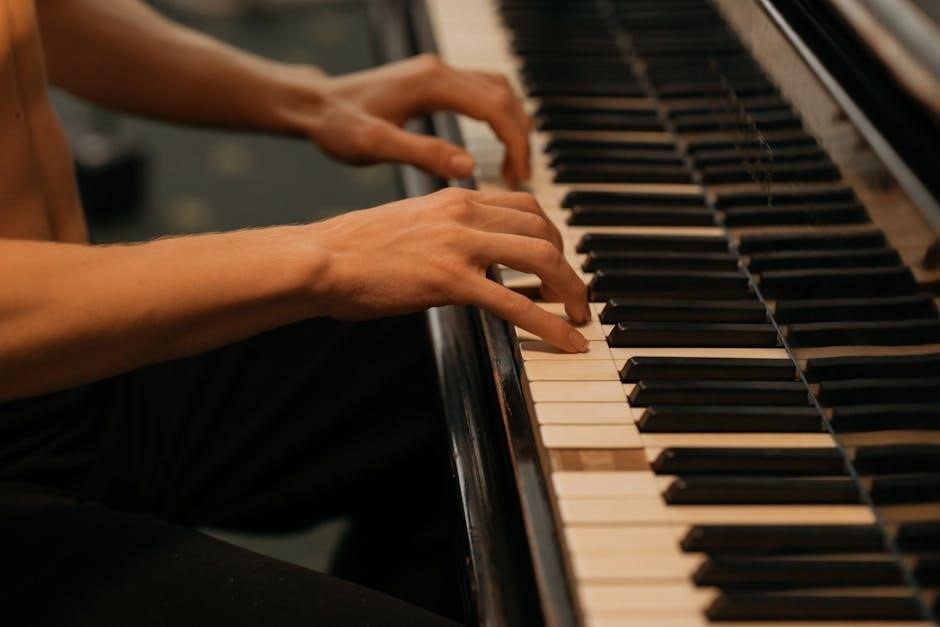
1.2. Why “Let It Be” is a Great Choice for Piano Beginners
“Let It Be” is an excellent choice for piano beginners due to its simplicity and timeless appeal. The song is written in the key of C Major, featuring basic chords like C, G, Am, and F, which are foundational for learning. Its moderate tempo allows for steady practice, while the repetitive structure makes it easy to follow. The emotional depth of the melody also provides a rewarding experience, helping beginners build confidence and technique. It’s a perfect blend of simplicity and musicality, making it ideal for new pianists to grow their skills.
Chord Progressions for “Let It Be” on Piano
“Let It Be” features a series of chord progressions in C Major, combining major and minor chords to create its iconic emotional sound. Mastering these chords is fundamental for playing the song and understanding chord sequences in music.
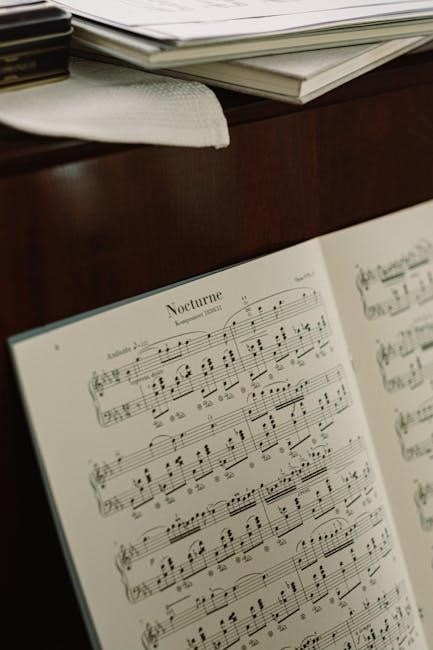
2.1. Verse Chords: C, G, Am, F
The verse of “Let It Be” is built around the chords C, G, Am, and F, creating a harmonically rich yet accessible foundation for beginners. Starting with C Major, the progression moves to G Major, establishing a positive, uplifting tone. The Am (A minor) chord introduces a touch of melancholy, while the F Major chord resolves the tension, preparing for the next verse. These chords are central to the song’s emotional depth and are repeated throughout, making them essential to master for a smooth performance.
2.2. Chorus Chords: F, C/E, Dm7, C
The chorus of “Let It Be” features the chords F, C/E, Dm7, and C, creating a powerful and emotive progression. The F Major chord sets a hopeful tone, while the C/E adds a sense of movement. The Dm7 introduces a touch of melancholy, and the C Major resolves the progression, reinforcing the song’s uplifting message. These chords work together to enhance the vocal melody, making the chorus memorable and impactful. Mastering this sequence is key to delivering the song’s emotional depth effectively.
2.3. Bridge Chords: Am, Fmaj7, F6
The bridge of “Let It Be” uses Am, Fmaj7, and F6 chords, creating a harmonic shift that adds emotional depth. The Am chord introduces a minor, reflective tone, while the Fmaj7 brings a hint of resolution. The F6 chord adds a subtle tension, leading smoothly back to the main progression. These chords enhance the song’s dynamic range, providing a moment of contrast before returning to the familiar chorus structure. This section showcases the song’s ability to evoke feelings through chordal texture and progression.

Finger Placement and Techniques
Finger placement starts with C Major, using index on C, middle on E, and thumb on G. Techniques include smooth transitions between chords and arpeggios for a melodic flow.
3.1. Basic Finger Placement for C Major Chords
For C Major, place your thumb on C, index on E, and middle finger on G. Keep fingers curved and close to the keys for optimal control. This placement ensures a clear, resonant sound. Proper hand posture and finger alignment are crucial for smooth chord transitions. Begin with this foundational setup to build confidence and technique when playing “Let It Be.”
3.2. Advanced Techniques for Smooth Transitions
To achieve smooth transitions, focus on finger independence and a relaxed hand position. Use legato playing to connect notes seamlessly. Practice chord changes slowly, ensuring each finger moves directly to its next note. Incorporate pedaling techniques to sustain sound and blend chords. Pay attention to rhythm and timing, as “Let It Be” relies on a steady, flowing tempo. Regular practice will refine your ability to transition between chords effortlessly, creating a polished performance.
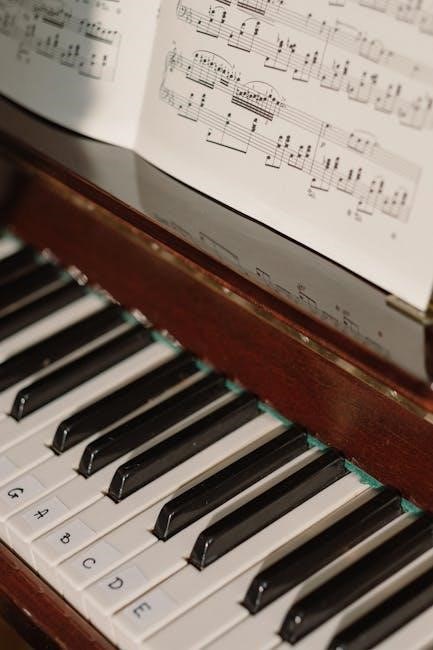
Downloading “Let It Be” Piano Sheet Music in PDF
Easily download “Let It Be” piano sheet music in PDF from reliable sources like Sheet Music Direct or Musicnotes. Explore free and paid options for high-quality sheets.
4.1. Reliable Sources for Free and Paid PDF Downloads
Find reliable sources for “Let It Be” piano sheet music in PDF format. Websites like Sheet Music Direct and Musicnotes offer high-quality, paid downloads with accurate arrangements. For free options, platforms such as SheetsFree.com provide chord sheets and basic scores. Ensure the source is reputable to maintain musical accuracy. These PDFs often include chord progressions, lyrics, and piano arrangements, making them ideal for practice and performance. Choose the option that best fits your needs and skill level for an optimal learning experience.
4.2. How to Print and Use the Sheet Music
After downloading the PDF, print the sheet music on standard paper for clear visibility. Ensure your printer settings are adjusted for high-quality output. Once printed, organize the sheets in order and consider binding them for easy use. Use the sheet music to practice chord progressions and melodies, marking finger placements and tempos. For better accuracy, review the notes and chords before playing. This organized approach will help you master “Let It Be” efficiently and enjoy a smooth performance. Regular practice with the sheet music will enhance your piano skills and musical understanding.
Step-by-Step Tutorial for Playing “Let It Be” on Piano
Start by practicing the verse and chorus chords separately, focusing on smooth transitions. Follow the chord progressions and finger placements to build confidence. Gradually combine sections for a seamless performance, ensuring tempo and dynamics align with the song’s emotional tone. Use the sheet music as a guide to master the melody and harmony, enhancing your overall piano skills through repetition and dedication. This structured approach will help you play “Let It Be” with precision and feeling.
5.1. Practicing the Verse and Chorus Separately
Begin by mastering the verse chords: C, G, Am, and F. Focus on smooth transitions between these chords to establish a steady rhythm. Once comfortable, practice the chorus chords: F, C/E, Dm7, and C. Pay attention to the emotional lift in the chorus, ensuring each chord change flows naturally. By isolating these sections, you can build confidence and accuracy before combining them. Repeat this process until both verse and chorus feel effortless, allowing you to focus on expression and dynamics during performance.
5.2. Combining the Sections for a Full Performance
Once the verse and chorus are mastered, focus on transitioning smoothly between them. Start by practicing the verse, followed by the chorus, ensuring a seamless flow. Pay attention to timing and dynamics, especially during the emotional peaks of the chorus. Gradually incorporate the bridge and outro, maintaining the song’s meditative quality. As you combine all sections, emphasize the iconic melody and chord progressions, allowing the music to breathe naturally. This step-by-step approach will help you deliver a cohesive and heartfelt performance of “Let It Be.”

The History and Background of “Let It Be”
“Let It Be” was written by Paul McCartney during a tumultuous period for The Beatles. Released in 1970, it became a timeless anthem of hope and reassurance.

6.1. The Beatles and the Creation of the Song
“Let It Be” was written by Paul McCartney during a challenging time for The Beatles. Released in 1970, it was part of their final studio album, Let It Be. The song was inspired by a dream McCartney had about his mother, Mary, who passed away when he was a teenager. The lyrics reflect a message of comfort and reassurance, resonating deeply with listeners. The song’s creation marked a poignant moment in the band’s history, as they were nearing their breakup. Its timeless appeal has made it one of their most beloved songs;
6.2. The Song’s Cultural and Emotional Impact

“Let It Be” has become a cultural anthem, offering solace during challenging times. Its universal message of hope resonates globally, transcending generations. The song’s emotional depth, combined with its iconic piano melody, has made it a favorite at charity events, memorials, and personal reflections. Its ability to evoke comfort and strength has cemented its place in music history. The piano version, in particular, highlights the song’s emotional layers, making it a timeless piece that continues to inspire and uplift listeners worldwide.
Mastering “Let It Be” on piano is a rewarding journey. Practice regularly, explore variations, and enjoy the emotional depth of this timeless classic. Happy playing!
7.1. Encouragement for Continuous Practice
Consistent practice is key to mastering “Let It Be” on piano. Start with slow tempos and gradually increase speed. Break the song into sections, focusing on chord transitions and finger placement. Celebrate small progress and don’t hesitate to seek guidance or resources; With dedication, you’ll enjoy playing this beautiful melody confidently. Remember, every practice session brings you closer to perfection. Keep going and embrace the joy of music!

7.2. Exploring More Songs by The Beatles
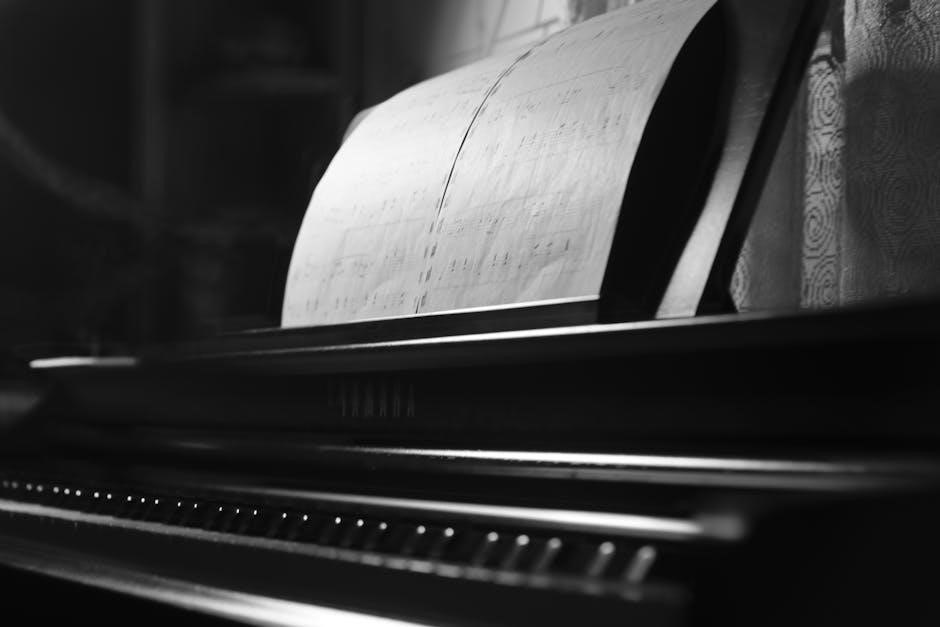
After mastering “Let It Be,” explore more of The Beatles’ iconic songs. Try “Hey Jude,” “Yesterday,” or “Imagine” for their beautiful melodies and chord progressions. These songs, like “Let It Be,” are rich in emotional depth and musicality, offering a rewarding experience for pianists. Each piece provides a unique learning opportunity, helping you grow as a musician. Dive into their extensive catalog and enjoy the journey through their timeless music!
